Find out more about the Cannes film festival and market in these video blogs featuring me and fellow filmmaker Sophie Black.
Directed by Neil
Blog posts from when Neil used to produce and direct his own micro-budget movies (2001-2014).
Grading Stop/Eject

On Monday, Stop/Eject entered the final phase of postproduction: grading. In the optical days, this process involved adjusting the cocktail of chemicals and the length of time the film would be bathed in those chemicals to make basic adjustments to the amount of red, green and blue in each shot and the brightness.
The reason for this can be most readily appreciated if you imagine a scene shot outdoors, in which one camera angle may have been recorded under warm, direct sunlight, whereas another which is cut to immediately after may have been recorded when the sun was behind a cloud and the light was cooler in colour. But even artificially lit scenes will need a little work to match up each shot to the next; the human eye is quite sensitive to changes in colour and brightness.
With the digital revolution came an exponentially expanded toolset for grading. Individual colours can be isolated and changed, shadows and highlights can be adjusted independently, and feathered masks can be applied to highlight or shade just one part of the frame – with the software even able to track elements if they move around so that the mask always stayed lock to that element. (Watch the Digital Intermediate featurette on the Fellowship of the Ring DVD to get a glimpse into what’s possible.)

Stop/Eject was graded by Michael Stirling at the company he runs in East London, White Cross Post Production. He very kindly put in a lot of hours, including two evenings, to make sure we got the best out of the film’s images. Even at this late stage in the game we were still telling the story: drawing the viewer’s eye to critical elements in the frame, enhancing lighting transitions when time stops and starts, making the happy past sequences warm and inviting, and contrasting those with cooler, darker scenes in the present.
Given that we shot in 16:9 (standard widescreen) but were cropping to 2:35:1 (cinemascope), we had the opportunity to move the images up or down behind the widescreen mask to reframe shots slightly; this is known as re-racking. We also added some subtle 35mm grain to the whole film.
The grade was the first time – and perhaps the last – that I was able to see the film on a really high quality, properly calibrated projector. It really exposed the quality of the camera and glass that were used. And while the Canon 600D and relatively cheap lenses look great on every other screen I’ve watched it on, on Whitecross’ projector I could really see the value of investing in high-end lenses. Even the difference between the Canon 50mm/f1.8 (£60) and the more expensive Sigma 20mm and 105mm lenses was apparent.
But I digress. The important things are: the grade looks great, and Stop/Eject is now finished. Hooray!
Sophie and I are off to Cannes this weekend – subscribe to my YouTube channel to get our daily video blogs. And when we get back it’s film festival submissions, DVD/Blu-ray authoring, and premiere arranging all the way.
Mixing Stop/Eject
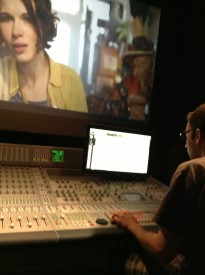
Yesterday I travelled down to London to sit in on the final mix for Stop/Eject. This is the last part of the filmmaking process as far as the audio is concerned. All of the disparate elements – dialogue recorded on set, dubbed dialogue (ADR), ambience, footsteps, effects and music – must be combined into one seamless whole.
Guiding the audience’s ears through the soundtrack of Stop/Eject was Jose Pereira, re-recording mixer. Alchemea, the college in north London where he works, very kindly gave us the use of their postproduction room, a very nice little studio with a big screen, cinema seating, surround sound monitoring and more knobs than Nobby the Nobber’s Knob Emporium.
The film sounded great already, thanks to the talents of sound designer Henning Knoepfel and Jose’s diligent pre-mixing. It was a very painless process to do the necessary surround sound positioning, adjust a few levels here and there and arrive at a final mix.
It was a world away from Soul Searcher, my first real mixing experience. Yes, Soul Searcher was a feature and yes, it had a lot of action, but looking back I can’t help but think it would have been much easier to mix if I knew then what I know now. Back then I was doing my own sound design, and I was convinced that quantity was quality, creating layer upon layer of noise which took an age to sort through and balance in the mix. I obstinately foleyed every footstep even when it had no hope of being heard under the music and gunfire. I believed logic was the key to every decision, that the same location had to have the same ambience every time we returned to it, even if the story and emotions would have been better served by something a little different. And I was determined to make as much use of the rear speakers as possible, even at the risk of confusing or distracting the viewer.
Now I know that less is more, that a few well-chosen sounds trump fifteen tracks of poor ones, that the rear speakers should be use sparingly and that you don’t always need to hear every clothing rustle and every footstep.
Anyway, with Stop/Eject’s sound mix in the bag, it only remains to grade the images, and I hope to have a date set up for that soon.
The One That Got Away
Meet the star of my next film, a Virgin Media Shorts entry called The One That Got Away.
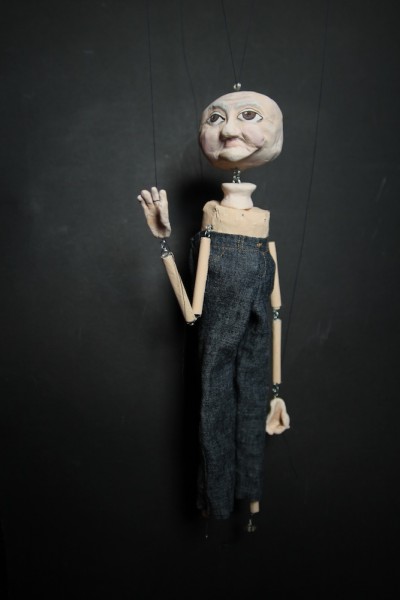
He’s being made by my wife Katie, on whose idea the film is based. As usual, you can follow the making of this project right here at neiloseman.com
Meanwhile Stop/Eject is within reaching distance of completion. All the music, sound and VFX are in place. This weekend the final credits roller will go on, and on Monday Jose Pereira and I will do the final 5.1 surround sound mix at Alchemea College near Islington.
Work is gathering pace on my next major production too, the title of which I’m still keeping secret. Currently the script is at fourth draft stage, and I hope to reveal some of the behind-the-scenes talent attached soon. Stay tuned.
Stop/Eject DVD Sneak Peek
It would be nice to be able to hand out DVDs and Blu-rays to the cast, crew and sponsors at the premiere of Stop/Eject. That means finishing the discs pretty sharpish after the movie is done. I’ve been working on the discs on and off for a while, and yesterday I shot the menus. Yes, you read that right. I shot the menus.
I feel that DVD/BR menus should be an extension of the world of the movie, and I figure: what better way to do that than to use footage from the film combined with new shots that appear to be in the same locations? So, for example, the Special Features menu is a shelf in the charity shop, where each item of junk represents one of the special features. Some of these were found in real charity shops, some of them were made by Sophie, and others were borrowed from friends (thanks to Colin, and Joel at the Rural Media Company). Before long I hope to officially announce the DVD and Blu-ray bonus features, but for now I’ll leave you to guess what each item might represent.


Back to the Future
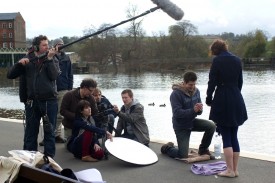
Like Janus I’m looking forwards and backwards today, the first anniversary of Stop/Eject‘s shoot beginning. First of all, here are a few key things I’ve learnt from making Stop/Eject:
- Pay people. It’s not worth the stress and hassle when unpaid cast and crew pull out at the last minute.
- Don’t do multiple jobs, even if you have the necessary skills. Delegate, collaborate, nurture the talents of others and save your own time so you can excel at the one thing you need to do.
- Get the script right before you shoot. I “learn” this with every film I do, and somehow forget it as soon as I get into preproduction on the next one.
- Directors shouldn’t edit their own films. It will be better if someone else cuts it. No exceptions. It’s as simple as that.
- Don’t shoot without a 1st AD, or at least a script supervisor. No director can keep all the important stuff in their head and run a shoot on schedule without help.
With the project drawing near to completion, my thoughts are turning towards my next films. As regular readers will know, writer Tommy Draper has been working on a feature-length version of Stop/Eject for some time.
However, I feel that trying to get a feature financed with me as director right now wouldn’t be much easier than it was a couple of years ago when I was trying to get The Dark Side of the Earth made. So I intend to make another short film first. It’s too early to reveal any details, but I can tell you that after advertising on Shooting People I’ve teamed up with a writer called Kevin O’Connor who is currently working on a third draft script based on a one-line idea of mine.
I’ll also be entering Virgin Media Shorts again this year, and my wife Katie is hard at work on a puppet for that. Intrigued? You ought to be.
Stay tuned for the latest news on all of these projects, and I’ll leave you with a reminder of what we were up to this time last year.
Recording Stop/Eject’s Music
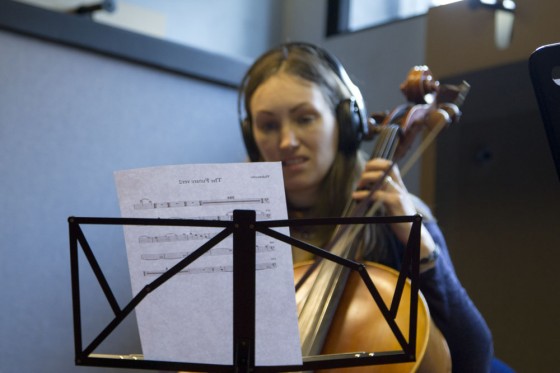
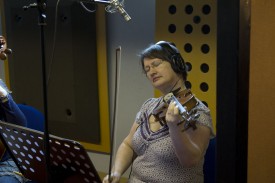
Yesterday saw the recording of Stop/Eject‘s score at Worcester College of Technology with four members of the Film Orchestra.
Recording music is similar in some ways to shooting a film. Time is precious, and the composer (or director) is constantly having to make judgement calls: do we record another take, or do we live with what we’ve got and move on? Shall I play that take back to check it’s okay or is it quicker just to record another one? Do we go from the top again or pick it up part way through? Can I fix it in post? Am I giving the performers what they need in order to do their best work? Is what we’re doing going to work with the other elements it will be combined with later?
As is often the case, recording started very slowly and gradually sped up (out of necessity!) as the day went on, eventually finishing just in time before the caretaker locked up the building. It was fantastic to hear the score come to life and, as with our first collaboration (Soul Searcher), Scott provided more than one musical moment that made me all tingly. He will now mix the live violin, cello, flute and clarinet with a sample-based piano and other instruments to create the final music tracks.
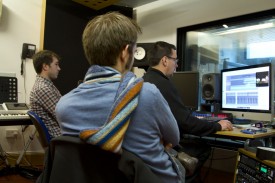
Big thanks to everyone who made yesterday possible: composer/conductor Scott Benzie, cellist Lorna Davies, violinist Heather License, flautist Sue Salsbury, clarinettist Jack Suttie, WCT staff Max Alexandre, Billy Craythorne and Craig Ward, student Kurt Teale, behind-the-scenes camera op Owain Uylet, and Jane Whittle, Simon Munn, Paul Bellamy and David Staiger for helping me get in touch with the right people to arrange everything.
If you’re in the Worcester area and you’re a musician who’s into your film scores, check out the Film Orchestra’s Facebook page.
Elsewhere in the world of Stop/Eject, the last of the visual effects shots are being mopped up, I’ve just heard the first draft of the sound design, Andréa Kristina’s song for the end credits is almost finished, and the last two pick-ups have been shot by Chris Newman and Sophie.
The Fundamental Interconnectedness of All Things
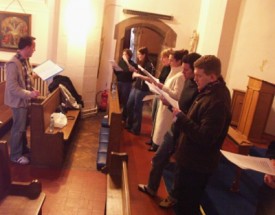
Next week we record the music for Stop/Eject at Worcester College of Technology with players from the Film Orchestra. I think it’s a shame that many low budget filmmakers are content to let the composer create the music in their home studio, often without using any real instruments at all. It’s true that it takes a little more organisation to record a score with live players, but the richness and authenticity of the sound you get is well worth the effort.
Let me explain how I was able to arrange this recording session, because it demonstrates the importance of building your contacts.
Once the score was written, I started with a simple shout-out on Facebook for musicians. This was seen by Simon Munn, who is part of my social media network because I gave a talk at the Worcestershire Film Festival, which he organises, last year. There are many benefits of giving talks, paid or otherwise (which I touched on in a previous post) and making contacts is one.
Simon put me in touch with Jane Whittle at the Film Orchestra, a group of amateur musicians based in Worcester. Several of their members expressed an interest in performing the music, so I knew that I needed to find a recording studio in Worcester to make it as convenient as possible for them.

Years ago I hung out with some friends while they were recording a demo for their band (King Monkey) at Worcester College of Technology, so I knew there was a studio there. I contacted Paul Bellamy and David Staiger, both Worcester-based musicians who were involved in the recording of Soul Searcher’s score back in 2005. I figured one of them probably had some link to the college and I was right; Paul works there. He put me in touch with the Head of Performing Arts and Music Technology, who was very enthusiastic about the whole idea, and from there it was just a case of working out the details. In return I offered to give a free guest lecture at the college, citing my prior experience at Hereford College of Art, the SAE Institute, etc.
There are two morals to this story. One is the value of networking, making new contacts and maintaining those contacts (which Facebook makes it really easy to do now). The second is, if you’re a young filmmaker struggling to get stuff made, remember that collaboration not only benefits your current project; you could be sowing seeds which will help your future projects too.
ADR Podcast
Here is a video podcast from the ADR (Automated Dialogue Replacement / Additional Dialogue Recording) session on March 15th, in which the actors explain some of the challenges of recreating their performances in a studio.
This is a belated public reward for passing the £1,400 mark in Stop/Eject‘s crowd-funding campaign (over two months ago!). See my earlier blog for more info about how the session went.
Thanks to Gerard Giorgi-Coll for filming this and Soundtree Music for the use of their studio.
Top Ten Crowd-funding Tips

To finish my look back at the decisions, successes and failures of the Stop/Eject crowd-funding campaigns, here are my ten top tips based on the sum of our experiences on this project:
- You need “elements” – aspects of the project which have an existing audience base, such as a name actor or a director with a strong social media following. Sometimes people will donate because the film is being shot in their home town, or maybe it’s about a subject they have an interest in. Whatever it is, figure out where that existing audience base is and what they want, and create your rewards and promotions accordingly.
- Work out in advance how much your rewards will cost to produce, and reject any that aren’t cost or time efficient. I suggest they should consume no more than ten percent of your budget.
- Make your pitch video professional – tightly edited, well lit, well shot and with broadcast quality sound. No-one will sponsor a filmmaker who can only be bothered posting a five minute ramble shot on a webcam. Your “elements” should appear in the video.
- Whether building your own crowd-funding platform or using an existing one, make sure it’s extremely quick and easy to donate, with a minimal number of clicks.
- A longer campaign doesn’t necessarily mean more money raised, but it does mean more work for you promoting it.
- If you take a day off from promoting your campaign, people will take a day off from donating. You cannot sit back and expect the money to roll in. It doesn’t work that way.
- Keep reminding people about your campaign, but do it indirectly by publishing new content like blogs, behind-the-scenes videos or storyboards. Most sponsors will have to see your campaign several times before deciding to donate.
- The internet isn’t the only way to promote your campaign. Go to events in the real world and plug it. Take a donations bucket or hand out cards or flyers with the campaign address on.
- Make people feel involved in your project, both during and after crowd-funding. Run competitions, invite feedback on things like poster designs, issue updates and answer questions.
- The endorsement of a well-recognised person or entity can give your campaign a massive boost. BBC Midlands Today putting a Stop/Eject report on their Facebook page worked for us, but the holy grail is getting a celebrity to retweet your campaign link.
If you’re still hungry to learn more about crowd-funding, check out James J. Heath’s Top 5 Crowd-funding Mistakes and Indiegogo’s Field Guide.
(Links to previous parts of the evaluation: part 1, part 2, part 3, part 4, part 5, part 6, part 7.)